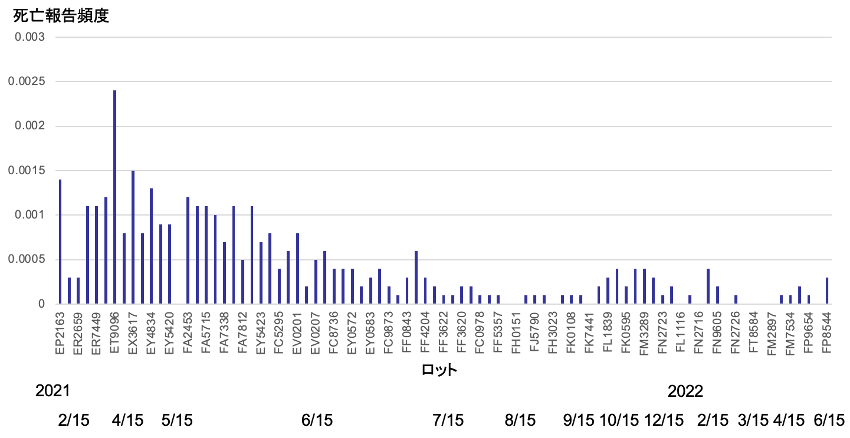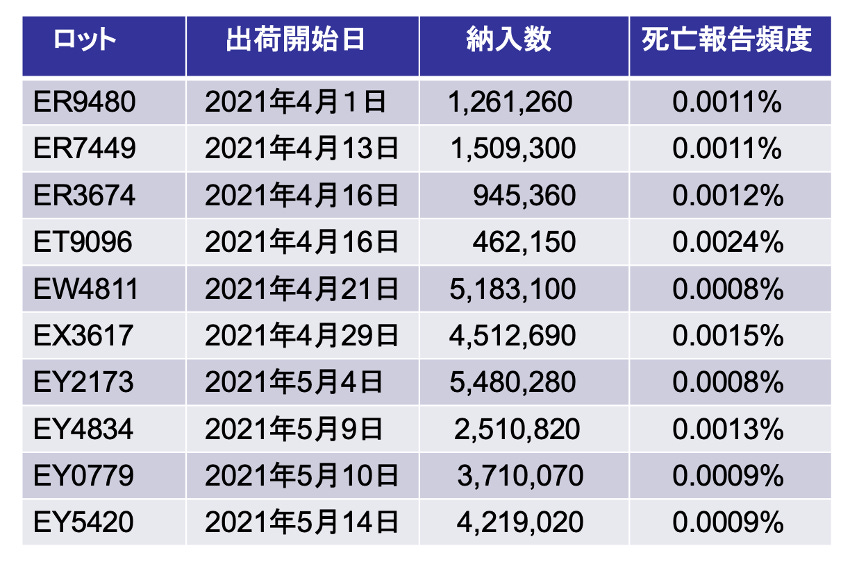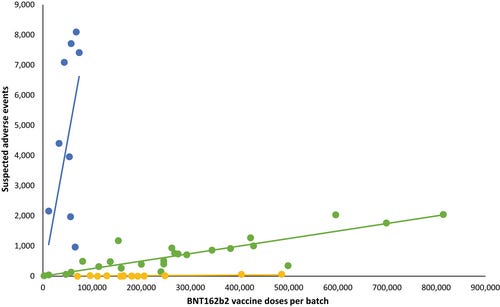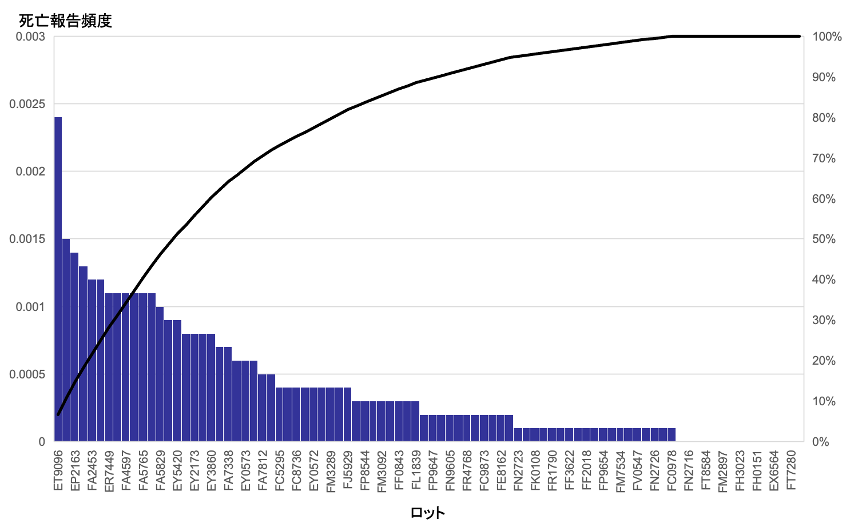I didn’t intend to translate Prof Kojima’s articles three posts in a row, but since Ashmedai already wrote about the study by a Japanese cardiologist whose patients’ mortality rate doubled after getting the Covid jab, I guess I might as well do so.
Prof Kojima’s article is titled “Visible differences in adverse events between Pfizer vaccine lots”. As before, all quoted text is his; highlights are mine.
The documents submitted to the Adverse Reaction Investigation Committee of the Immunization and Vaccine Committee of the Health Science Council disclose the number of doses delivered, the number of serious adverse reactions reported, the number of deaths reported, and the frequency of death reports for each lot.
Figure 1 shows the frequency of death reports for each lot. The highest reported lot frequency was 0.0024%, with 9 lots having 0%. The median value was 0.0003%, with 13 lots having ≥0.001%.
Figure 2 shows the reported frequency of serious adverse events (AEs), which also show significant differences between lots. Serious is defined as 1) death, 2) serious injury, 3) things feared to lead to them, 4) hospitalisations, etc.
Figure 3 shows the delivery timing of each lot. The death reporting frequency for all lots delivered after July 2021 was 0.0005% or less. On the other hand, among the 20 lots delivered during April and May 2021, 12 lots had a death report frequency of 0.001% or higher, and the frequency of death reports differed greatly depending on the delivery time.

Table 1 shows the shipping date of each lot, the number of doses per lot, and the frequency of death reports. ET9096, which had the highest reported death rate of 0.0024%, contained a remarkably low number of doses, 462,150. The reason for the low number of delivered doses may be that this lot was realised to be dangerous and shipments were stopped.

One possible limitation of these data is that we don’t know the usage rates of these lots, so these results would be misleading if 100% of ET9096 was used but only 50% of EY2173, for example, was used. But that still doesn’t explain why AE frequency is 10-20 times higher for earlier lots than later ones.
To support his findings, Prof Kojima cites a study that found similar heterogeneity in Denmark, with lots comprising 4.22% of doses accounting for 70.78% of reported AEs, 27.49% of serious AEs, and 47.15% of reported deaths.

It’s probably worth noting that most AEs that actually get reported occur shortly after vaccination, so these data can’t tell us much about differences in longer-term AEs among lots. That said, the manufacturer and regulators claim these data can’t tell us anything at all.
Although Pfizer and the Ministry of Health, Labor and Welfare (MHLW) deny that there are lot-to-lot differences in the risk of death, looking at the data published by the MHLW, we have to admit that differences do exist.
Pfizer’s Covid vaccine is made by wrapping mRNA, which contains the blueprint for the spike protein, in a lipid nanoparticle (LNP), but the amount of mRNA contained in the LNP is known to vary. Since the spike protein produced depends on the mRNA content, the amount of spike protein produced in the body may also vary between lots.
AEs after Covid vaccination, including myocarditis and pericarditis, are thought to be due to the toxicity of the spike protein.
…
The reason the frequency of death reports decreased is likely to be a decrease in the mRNA content of lots delivered after July 2021.
Uniform quality assurance is one of the most important issues for pharmaceuticals.
The pharmaceutical application document for the Pfizer vaccine describes quality control methods and lists encapsulated RNA, RNA content, and lipid content as quality characteristics that affect the safety of the formulation, so Pfizer may have recorded the RNA content of each lot. The marked decrease in the frequency of death reports for lots delivered after July may be due to changes in the standards for the RNA content of shipped lots.
This is consistent with something Robert Malone recently wrote: “In the USA, the inoculations were unequally distributed and the formulations of the initial shot and the booster were not the same. So, it is difficult to compare adverse event frequencies and even the adverse events.” The highlighted part was news to me, but I guess he’s in a better position to know. The first round of boosters were given out in Israel and the US in summer 2021, so the timeline fits.
But even if Prof Kojima’s hypothesis is true, Pfizer and BioNTech aren’t going to admit they’ve fixed the early safety issues because that would mean admitting there were early safety issues that needed fixing.
This large difference in the frequency of death reports between lots may be related to the fact that the time from development to market for mRNA preparations was particularly short compared with other drugs. In Japan, this may be a case subject to the Product Liability Law.
I don’t know the law well enough to determine whether emergency usage authorisations cover hot lots, but the idea of suing the manufacturers for poor quality assurance isn’t completely theoretical. A man in the US who “suffered a stroke after receiving Remdesivir that was contaminated with glass particles” is suing Gilead Sciences. But even if it is possible, it won’t happen in Japan, where the the Covid jab makers have received far more protection than they’ve given in return.







Cheers Guy, great work, and thanks as always!
Some other friends of mine in Tokyo are working on vial content analysis in conjunction with batch analysis in the hopes of verifying the 'whys and hows' batch/lot adverse events appeared to vary significantly from lot to lot. Very clever bunch of researchers indeed.
And there is always this site: https://howbad.info/index.html
Take care fella and have a great week.
I am all for keeping an open mind, but any investigation which attempts to assign causation of adverse events to "bad batches" raises doubts in my mind. As Bret Weinstein has noted, a simple explanation of the mechanism of injury is that the mRNA technology forces the body's own cells to produce a particle (here the spike protein) that causes an autoimmune response. The body's T-cells kill our own cells that present the foreign particle. The minute it was established that the mRNA does not remain locally in the injection site, there was a clear plausible explanation for injuries. After all it's one thing to kill off some muscle cells in one's shoulder in order to develop an effective immune response, but it is another thing to trigger the body's immune system to attack various organs and systems in an "autoimmune cascade."
Paul Offit has attempted to "save" the mRNA platform by suggesting that the problem was develoeprs selected the wrong particle--the spike protein. So he blames the injection, but asserts the next time mRNA developers will get it right. But if the entire platform is the cause of the injury because of the obvious autoimmune challenges it creates, then mRNA "vaccination" is likely to fail every time.
The "bad batch" argument is similar. It solely places blame on the manufacturing process and acquits the mRNA platform. To be sure there are other plausible ideas about mechanism of injury such as Mark Girardot's "bolus" hypothesis--where failure to aspirate the needle to assure that a blood vessel has not been intersected results in a large "bolus" of product directly reaching the heart and other areas of the body. But the autoimmune hypothesis is strong, and so though I am open to "hot lots," I remain skeptical.